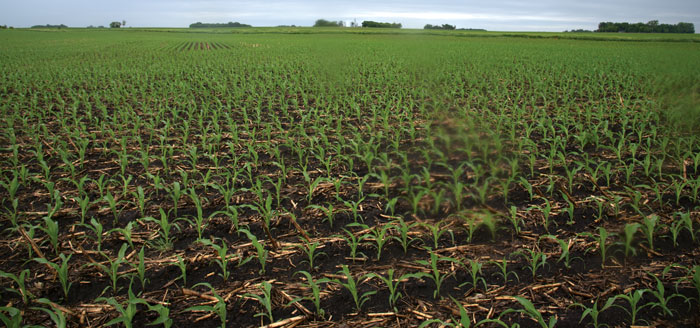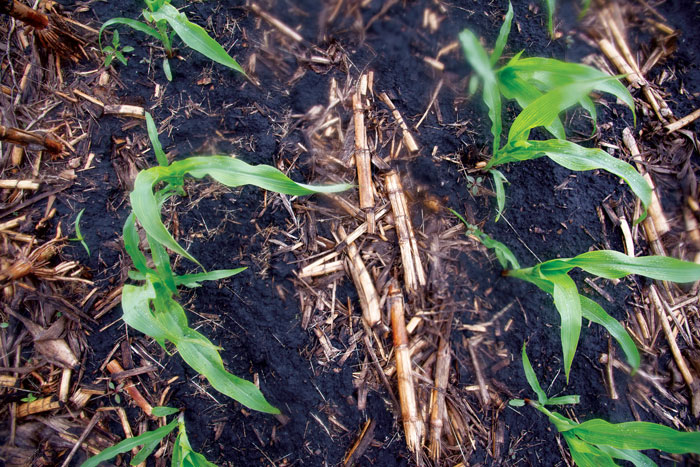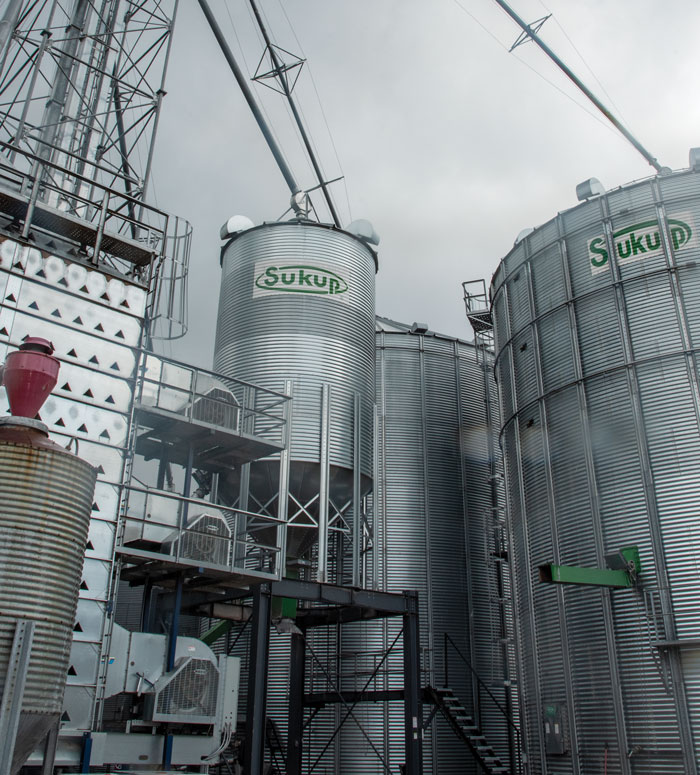The 2022 Strip-Till Innovator Award program is sponsored by

Using a combination of strip-till and cover crops, Brian Ryberg is changing the image of sugar beet farming in the U.S.
Ryberg, who farms about an hour and half west of Minneapolis in Buffalo Lake, Minn., was the first farmer to strip-till sugar beets in Minnesota, the nation’s largest sugar beet producer. His award-winning strip-till, cover crop and soil health practices — in addition to his commitment to educating other farmers about strip-till — make Ryberg a deserving winner of the 2022 Strip-Till Innovator Award.
Ryberg, his wife and his four full-time employees farm 5,200 acres of corn, soybeans and sugar beets in four counties in the Buffalo Lake area. They’re raising about 3,000 acres of corn, 1,500 acres of soybeans and 725 acres of sugar beets in 2022. They also custom farm another 1,000-1,500 acres.
Ryberg says they strip-till 80-90% of their total acres. The remaining acres are vertical-tilled ahead of soybeans. The conservation tillage methods are a far cry from the heavy tillage practices of most of his neighbors. He recalls a friend who, upon finding out Ryberg was going to try strip-till, tried to talk him out of it by arguing it would never work.
Strip-Till Specs
Name: Brian Ryberg, 2022 Strip-Till Innovator
Location: Buffalo Lake, Minn.
Acres: 5,200 plus an additional 1,500 acres of custom strip-till
Years Strip-Tilling: 9
Crops: Corn, soybeans, sugar beets
Soil Type: Heavy clay loam
Annual Precipitation: 25 inches
Irrigation: None
Livestock: None
“Of course, the more he talked, the more I wanted to prove him wrong,” Ryberg says. “We think we’re doing the right thing, and it’s working.”
In fact, Ryberg believes he’s gained a lot of respect over the years for what he’s doing. He says Ryberg Farms has done custom work for other farmers interested in trying strip-till, and a number of agronomists and landowners have given him their support.
“I’ve had landowners who have recognized what we’re doing, and we’ve been able to expand because of that,” Ryberg says. “They want people to practice things like we’re doing. It’s been a big advantage for us.”
Strip-till is also saving Ryberg money on inputs and fuel. He estimates that he cut his phosphorus (P) and potassium (K) rates by 25% because the operation is more efficient with application and more diligent with applying what’s needed where it’s needed. Pulling his SoilWarrior strip-till rig burns 0.6-0.8 gallons of fuel per acre, compared to the up to 4 gallons of fuel per acre he was using just for fall tillage in a conventional tillage system.

RICH STRIPS. Vibrant green corn emerges in rich black strips in a field next to Ryberg’s farm shop. “We have heavy clay soils with very good top soil and high organic matter,” Ryberg says.
“When fuel was $1.25, people didn’t think that was a big deal, but I’ve had people confront me now and say, ‘Holy cow, you’re saving a lot of money on $5 fuel,’” Ryberg says, “and we are. We planted 6,500 acres this spring, and we’re still pulling from the same 7,300-gallon tank of fuel.”
Saving Soil, Costs
Like most of his neighbors, Ryberg was doing heavy tillage in the fall and spring prior to switching to strip-till. But in 2013, he made an observation that made him rethink his methods. He discovered the corn growing in a section of a field that was recently pasture land was greener and taller than the corn on the long-term conventionally tilled ground.
“I started to question what we were doing,” Ryberg says. “I started to think about our soil structure and how we had to do something different. At the same time, the corn market was dropping, so we knew we had to cut back our costs. We fell into strip-till as more of a cost-savings measure than anything else.”
Strip-Till Takeaways
- Strip-till saves on inputs and fuel while also improving soil health. Ryberg estimates he cut his phosphorus and potassium rates by 25%. He uses 0.6-0.8 gallons of fuel per acre running his strip-till rig, compared to up to 4 gallons per acre on just fall tillage in a conventional system.
- Residue management is especially important in 22-inch rows. Ryberg uses Calmer stalk rolls on a corn head to size the residue and drop it next to the standing stalk. He also runs a vertical-till machine after harvest to size the residue and flatten the corn stalks.
- Strip-till and cover crops work well together. Ryberg likes using cereal rye because it germinates around 37 degrees F. He’s leery of making fall strips into radishes or turnips because the large tubers could create problems for the strip-till machine.
Ryberg and his farm crew demoed a strip-till bar in fall 2013, and one year later, they started strip-tilling all of their acres. They were a bit apprehensive about taking on their own fertility — they had always relied on the co-op to spread nutrients — but they figured out how to make it work.
Ryberg and his four hired hands specialize in certain areas of the operation. Ryberg sprays in the spring. His nephew, Chris, and a long-time employee, Jason, run 24-row and 36-row John Deere planters in the spring while Ryberg puts on pre-emerge chemicals behind them. The other two employees operate the seed and chemical tenders.
Through the spring and summer, Jason sidedresses N on corn, while everyone else runs sprayers and tenders, and handles other farm responsibilities. In the fall, two guys run combines, one runs the grain cart and Ryberg, “the sugar beet guy,” runs the sugar beet harvester. He also brings in part-time help to harvest and haul the crop.
“We gravitated to each guy running a certain piece of equipment and being really good at it,” Ryberg says.
Sugar Beet Management
Ryberg Farms is on a 5-year rotation of corn, soybeans and sugar beets. The rotation requires careful management because sugar beets are sensitive to certain chemicals and grow best on pattern-tiled ground.

RAIN & RESIDUE. Residue between Ryberg’s strip-tilled corn helps keep soil from running off his fields during heavy rain. Ryberg uses Calmer stalk rolls and a vertical-till machine to size the residue after harvest.
“We’re very cautious about the chemistry we use, and we use that on all of our acres so we stay consistent,” Ryberg says. “We try to prepare 2 years ahead of when we’re going to grow beets to give the crop the best chance to succeed.”
Sugar beets determined what kind of strip-till rig Ryberg Farms would use, too. Environmental Tillage Systems (ETS) was one of few companies that made equipment for 22-inch rows, the typical spacing for sugar beets. The company’s headquarters in Faribault, Minn., are only 75 miles away from Ryberg, so he felt good knowing he’d have experts nearby as he got started with strip-till. He’s made some upgrades to his SoilWarrior, but he’s still using the original machine he bought in 2014.
The 22-inch rows presented a challenge for managing residue, which Ryberg says was his biggest problem when starting out with strip-till. He had to be good at managing residue so the corn stalks wouldn’t plug the 22-inch triple coulter machine. This meant moving away from a chopping corn head and instead using Calmer stalk rolls on a corn head. The stalk rolls size the residue and drop it straight down so the residue lies alongside the standing stalk.
Ryberg also runs a vertical-till machine after the corn harvest to better size the residue and flatten the corn stalks. Flattening prevents the corn stalks from acting like a snow fence and catching residue, which then covers the strips. Flattening also makes the field uniform ahead of planting sugar beets.
“Just like corn-on-corn, you want the blackest strip you can get for sugar beets,” Ryberg says. “It warms up in the sunlight in the spring to get the plant off to a quick start.”
“We cut our P and K rates by 25% because we’re being more efficient…”
In his first year strip-tilling, Ryberg wondered if he was making a mistake by leaving the residue on the field. But when he looked out the back of the tractor and saw the black strip, he reassured himself that it would work out.
“I had to tell myself that all the sugar beet knows is it’s in a black strip,” Ryberg says. “It doesn’t care what’s next to the row. It worked out just fine.”
Farming by the Foot
The 24-row SoilWarrior strip-till is run by Chris. He chases the combine and makes most of the strips in the fall. Ryberg says they didn’t like the idea of having heavy machinery in the field ahead of planting, although they never had any compaction issues when they tried spring strip-till in the past. Chris tills an 8-10 inch strip, depending on the soil type, and runs the coulters about 4-6 inches deep.
The SoilWarrior is 44 feet wide with twin bins. Chris applies P, K and some micronutrients in the fall. Anywhere from 100-450 pounds of product is applied to 2.5-acre grids at a variable rate.
“We’re trying to farm by the foot,” Ryberg says. “It’s always driven by the soil test. We work with an agronomist to put variable-rate maps together, and then Chris plugs them into the system. We’re trying to get more balanced fertility.”
Nitrogen (N) is applied in the spring with the planter and a sidedress pass, partially because Ryberg was in a NCRS Conservation Stewardship Program that required spring N application. He also believes in spoon-feeding N to avoid losing it through leaching. He sidedresses N using Y-Drops, rather than putting it in the middle of the row, to keep the N as close to the plants’ roots as possible.
“Our focus with the strip is to keep all our fertility as close to the root zone as possible,” Ryberg says. “We’re even banding right over the row with some fungicides on sugar beets. We’re trying to target where the roots are and trying to be the most efficient we can with the fertility and any treatments.”

ON-SITE STORAGE. The grain bins outside of Ryberg’s farm shop in Buffalo Lake, Minn., store about 400,000 bushels of corn. A second site on another property stores about 350,000 bushels of corn and soybeans.
They run about 200 pounds of N on corn-on-corn. Almost all of it is 32%, but a small percentage comes from monoammonium phosphate (MAP) or diammonium phosphate (DAP) fertilizer applied in the fall for P and K needs. About a third is applied with the planter, a third is used as a carrier for a weed-and-feed application, and the last third is sidedressed when the corn is at V6. Corn-on-soybeans and corn-on-sugar beet ground get about 160 pounds of N total.
Ryberg also has a co-op spread lime in the fall after harvest for fields going to sugar beets. On average, each acre receives about 3 tons of lime, but the rate varies from 1-5 tons based on the pH of those 2.5-acre grids.
“We try to put lime on 2 years ahead of when we have beets,” Ryberg says. “You have to prepare for that crop to give it the best chance to succeed.”
Cover Crop Benefits
Cover crops also help Ryberg’s sugar beets — and other crops — succeed. Around the same time he started strip-tilling, Ryberg decided to try seeding cereal rye as a winter cover crop to keep the soil on his sugar beet ground in place.
Sugar beet ground has no residue after harvest, and the harvesting process results in fine black soil that blows around easily. After several winters without snowpack, Ryberg’s soil ended up in the road ditches.
Ryberg decided to try seeding cereal rye as a cover crop right after the sugar beet harvest. He used a pull-type spreader from the co-op to seed the rye and then used a field cultivator to go over it. The rye started growing in the fall, overwintered and then grew again in the spring.
“The first few years we had really good growth,” Ryberg says. “We had some warm falls and I thought this was very simple. Well, since then, we’ve had very few warm falls to allow that to happen.”
“All the sugar beet knows is it’s in a black strip. It doesn’t care what’s next to the row…”
Cereal rye is still Ryberg’s go-to cover crop. Ryberg says it germinates around 37 degrees F, so it starts greening up any time snow melts and grows rapidly in the spring. He seeds 45-50 pounds on the sugar beet acres and is considering going up to 60 pounds on the corn acres because some of the seed seems to get tied up in the cornstalk residue. Ryberg likes planting soybeans green into the standing rye in the spring and uses Roundup to terminate it.
“If you get growth to the cereal rye, it lays down when it’s terminated, shields the soil, prevents more weeds from coming up and insulates the soil,” Ryberg says. “The corn plant tends to shut down around 95 degrees, so if we can maintain that soil temperature and insulate a little bit, maybe we have a better chance to keep the corn growing.”
He experimented with interseeding different cover crop mixes into his corn crop, and putting a box onto the sidedress bar to apply N and covers in one pass. The cover crop got established, but the tight canopy in the 22-inch rows prevented it from getting sunlight.
“By harvest it would die,” Ryberg says. “Very few falls did we have anything green in the corn. Our budget was $15-16 an acre, and if we weren’t getting any return, it just didn’t pay to do that anymore.”
Since then, Ryberg’s focus has been seeding cereal rye in the fall on sugar beet acres and corn ground going to soybeans. He received a grant in 2021 that allowed him to purchase an older TerraGator with a spreader box on it. He plans to use it to spread covers on several farms ahead of the vertical tillage machine. This year will be a mix of cereal rye and oats. Ryberg hopes the oats will start growing faster in the fall.
“We can hopefully get more acres covered in the fall and have a larger percentage of our farm under cover crops,” Ryberg says.
Strip-till and cover crops work nicely together in Ryberg’s experience. Just about all the cover crops and application methods he’s tried have worked. He says he’d be leery of making fall strips into radishes or turnips — the large tubers could create problems for the strip-till machine — but he hasn’t had many issues with any of the covers he’s tried.
Amid high fertilizer costs, Ryberg plans to experiment with how cover crops can provide a fertility benefit. He wants to determine how to measure the benefits and ensure he’s not degrading the soil he’s worked so hard to improve.
“We cut our P and K rates by 25% because we’re being more efficient, but we’re also watching our grid testing to make sure we’re not burning up those nutrients and not replacing them,” Ryberg says. “That’s still a learning process. With high grain and fertilizer prices, you don’t want to give up the chance to produce a really good crop. You have to be very cautious about that.”
Educating Others
Ryberg proves strip-tilled and cover-cropped sugar beet ground can be successful, and he’s educating other farmers about his experience through his involvement with the Sugarbeet Research & Education Board. Having so much soil moving around “has always been a black eye” for sugar beet growers, according to Ryberg.
“If we truly want to see these practices spread, it’s up to us to share the message…”
“When I came on the board, I promoted cover crops to help address erosion, and people just laughed at me,” Ryberg says. “Now they know we need to do something. It’s nice to see people become more aware of better stewardship to keep the soil where it belongs.”
Ryberg says he’s built a network of strip-tillers through his involvement with the sugar beet board and other organizations. They share ideas and knowledge with each other to help everyone find success.
“There are too many people who will try something, and if it doesn’t work perfectly the first time, they just scrap it,” Ryberg says. “I don’t want that to happen to somebody because I really believe this is a good system.”
Ryberg is always willing to mentor other farmers looking to try strip-till, and he hosted field days focused on strip-till in 2016-19. The Fertilizer Institute recognized him as a 2020 4R Advocate for his focus on nutrient stewardship, and he also received 2 awards from the Soil Health Partnership for his efforts to improve and protect his soil health. In 2021, the American Soybean Association named him as the National Conservation Legacy Award winner, noting how incorporating strip-till and cover crops make Ryberg’s operation more economical and environmentally responsible.
“If we truly want to see these practices spread, it’s up to us to share the message and help everybody along,” Ryberg says. “I’ve got local people who are doing their full-scale tillage, but they’re trying cover crops to keep the soil where it is. That’s a step in the right direction.”







